Rava dosa (also known as Suji ka Dosa) is a quick and popular variant of dosa from the South Indian cuisine. These are crispy, netted and thin crepes made with semolina (rava or cream of wheat), rice flour, all purpose flour and spices. These are incredibly easy to make and require no grinding or fermentation, unlike the traditional Dosa Recipe. Make a truly crispy Rava Dosa recipe – one that you will make again and again for a quick breakfast or snack.
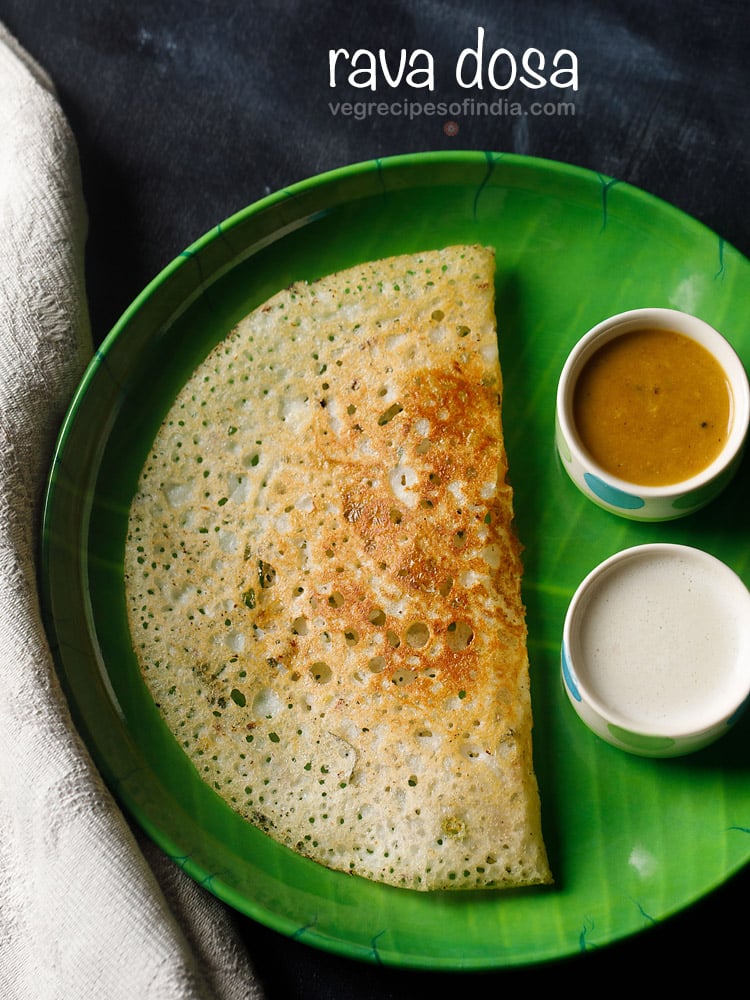
About Rava Dosa Recipe
Rava dosa is one of the quick breakfasts I make on occasion. At home, we prefer to add onions and some spices to them.
So I usually add onions, ginger, green chilli and some spices to the batter. At times I even add some chopped cashews. The addition of these ingredients makes the dosa more flavorful and tasty.
You can choose to make the suji ka dosa plain or you can spice it up by adding chopped onions, curry leaves, herbs and spices etc like I have done here.
Here I am sharing my mom’s recipe which is made without curd (yogurt) or buttermilk. Plain water is used to make the batter.
Table of Contents
You can even use curd or buttermilk instead of water to make the batter. This recipe can also be halved or doubled or tripled according to your needs.
If you do double the recipe, then use two tawa or skillets and cook the dosa side by side on two stovetop burners.
A thin batter is made of sooji, rice flour, maida and water or buttermilk. The batter is spiced with onions, green chilies and some more herbs & spices.
The batter is then poured on a hot tawa (griddle) to get netted effect on the dosa. The dosa is cooked till golden crisp and then served hot.
To make perfect crispy instant rava dosa which has a netted texture, the batter has to be thin. So always remember that the batter should be thin, runny and easy to flow.
Also allow some soaking time for rava or suji, so that they soften. I usually mix everything and set the batter aside for 20 to 30 minutes.
How to make Rava Dosa
Make Thin Batter
1. Take ½ cup unroasted fine rava, ½ cup rice flour and ¼ cup all-purpose flour in a bowl.
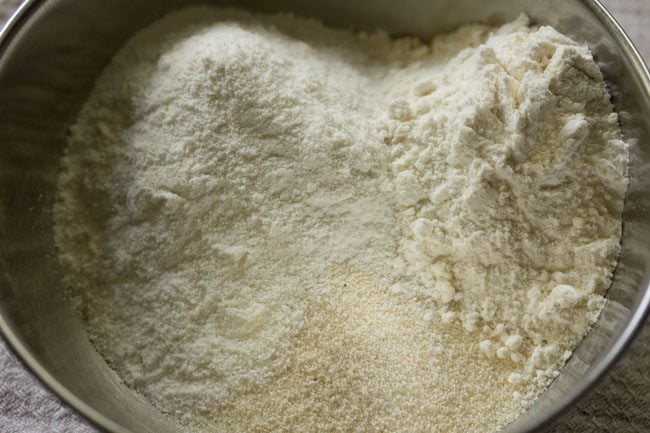
2. Then add ⅓ cup chopped onions, 1 or 2 green chillies (about ½ to 1 teaspoon finely chopped), and ½ teaspoon finely chopped ginger.
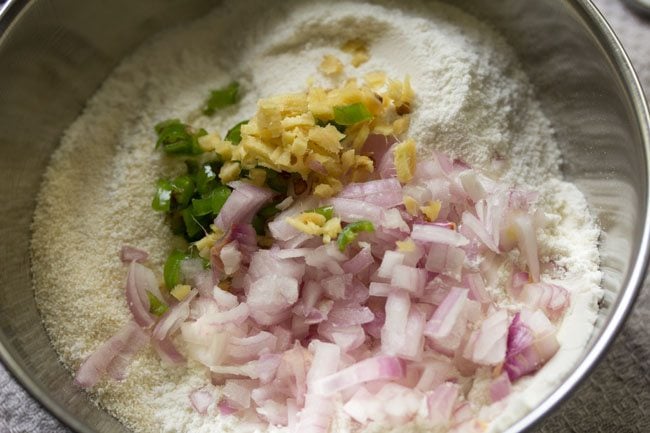
3. Also add ½ teaspoon crushed black pepper, ½ teaspoon cumin seeds, 8 to 10 curry leaves (about 1 tablespoon chopped) and salt as required.
At this point you can also include 1 to 2 tablespoons of chopped coriander leaves, 2 tablespoons of fresh grated coconut or 1 to 2 tablespoons of chopped cashews.
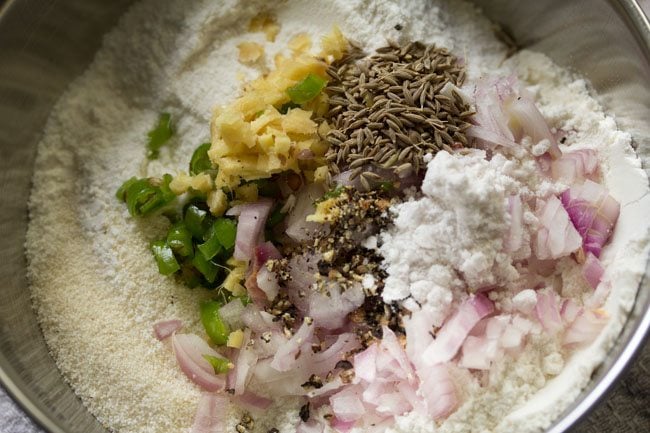
4. Add 2.25 to 2.5 cups water. Depending on the quality of rava or suji and rice flour, you can add less or more water – from 2 to 2.5 cups water.
I added 2.25 cups of water. You can also use buttermilk instead of water.
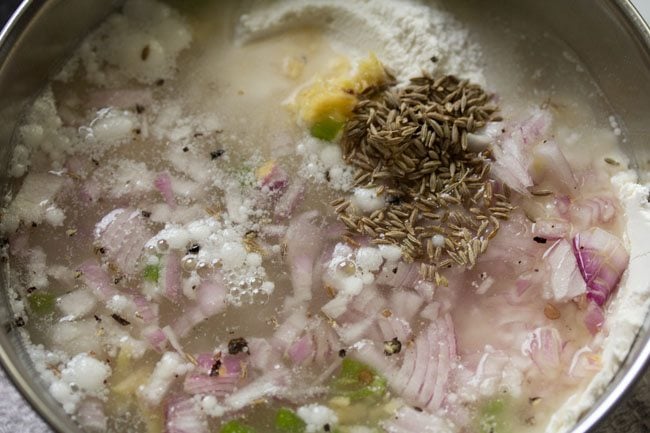
5. Whisk till smooth without any lumps. The batter has to be flowing and thin.
Tip 1: If the batter looks thick or has a medium consistency, then add more water.
Tip 2: If the batter looks very thin and runny, then add some rice flour.
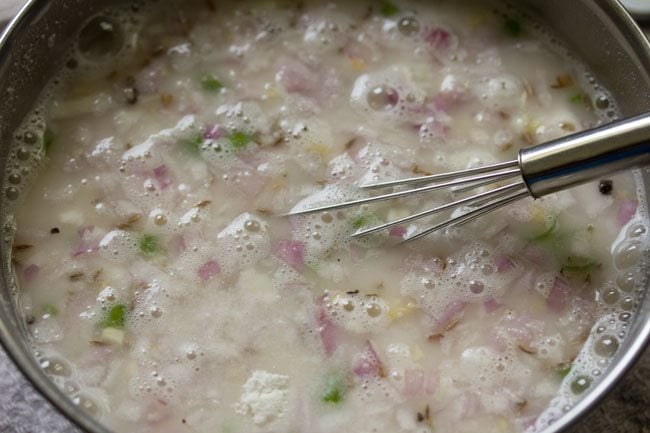
6. Cover and let the batter rest for 20 to 30 minutes.
Once the batter rests, you will see that the rava and the flours have settled down and the water will be floating on top.
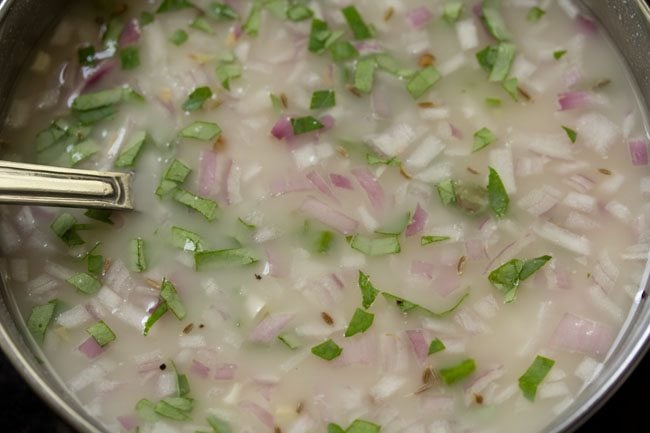
7. Before preparing dosa, mix the batter very well so that the flours and semolina that are at the bottom of the bowl are mixed evenly again.
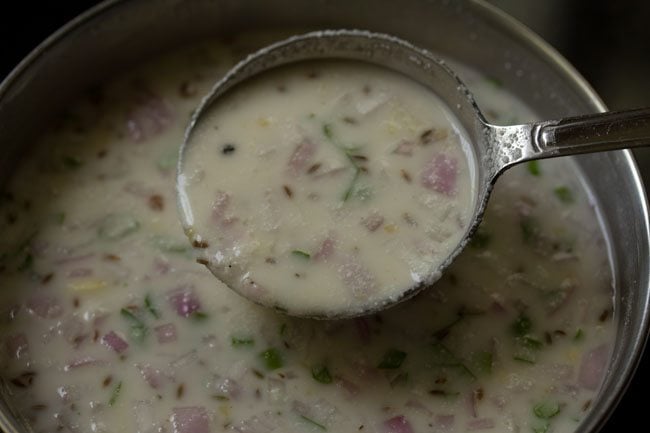
Make Rava Dosa
8. Spread some oil on the tawa or skillet. Do make sure that the tawa is hot. Keep the flame to medium or medium-high before pouring the dosa batter.
You can also use butter or ghee or coconut oil. Sometimes I use coconut oil and it gives a really good flavor.
If using a cast iron skillet, I recommend to use one that is well seasoned. So that the batter does not stick to it. You can check below my tips on seasoning the cast iron skillet.
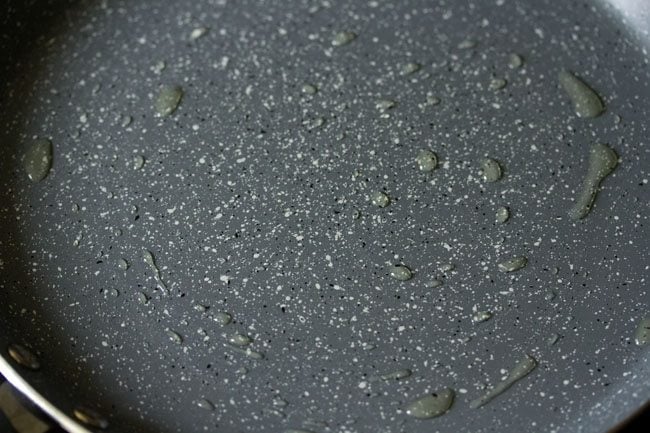
9. With a ladle pour the dosa batter. Start from the edges move towards the center.
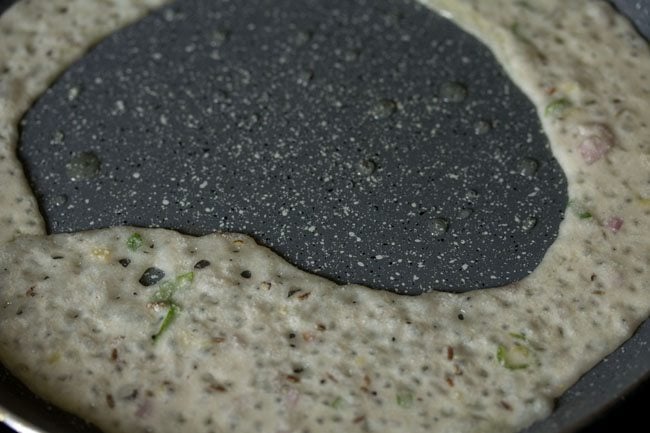
10. If there are big or small gaps, then fill them lightly with the batter.
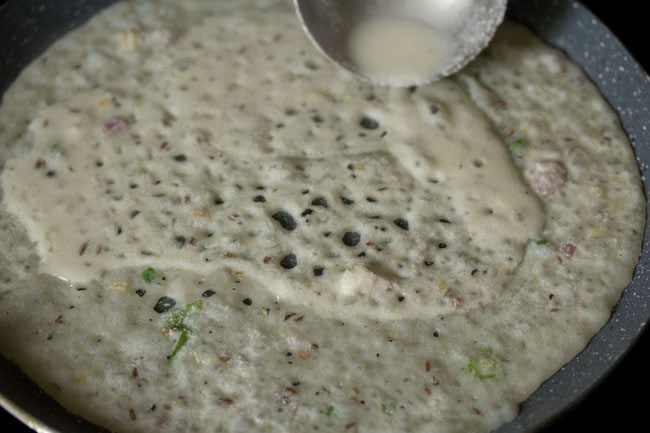
11. On a medium-low to medium heat, cook the dosa. If the tawa or pan becomes too hot, then you can reduce the heat.
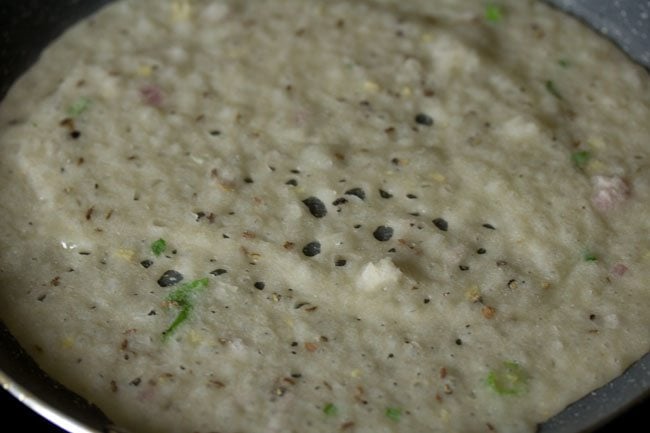
12. When the top side firm up and looks cooked, then sprinkle ½ to 1 teaspoon oil on the top and sides.
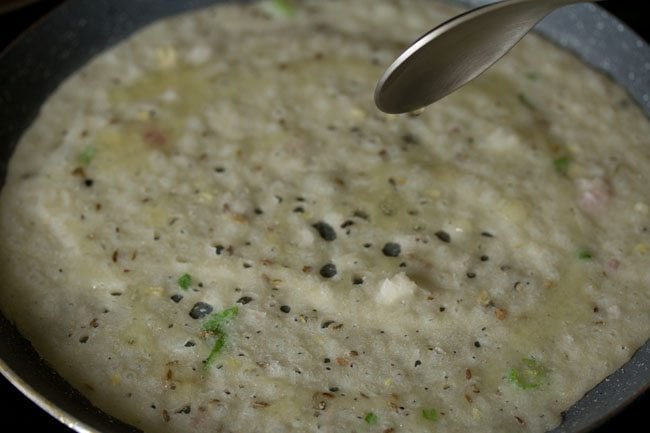
13. Spread oil all over the dosa with a spoon.
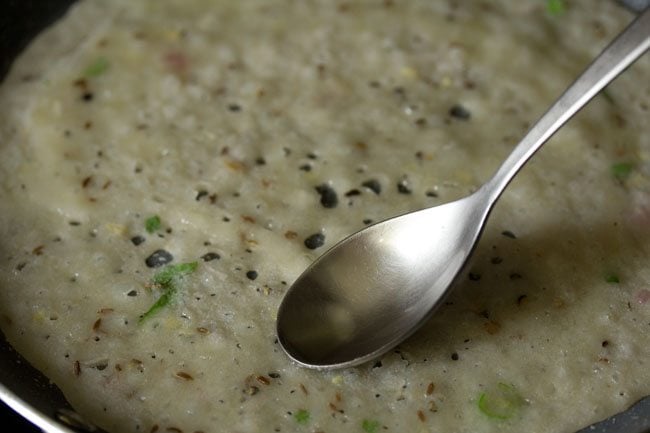
14. Instant rava dosa takes a little longer time to cook than the regular plain dosa.
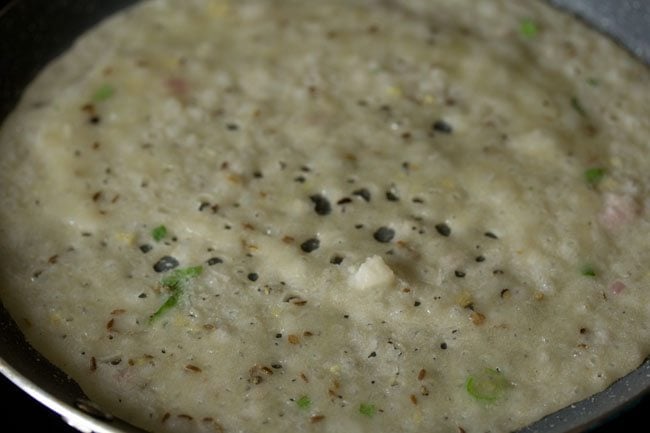
15. Cook till the base is golden and crisp. The edges will also separate from the pan.
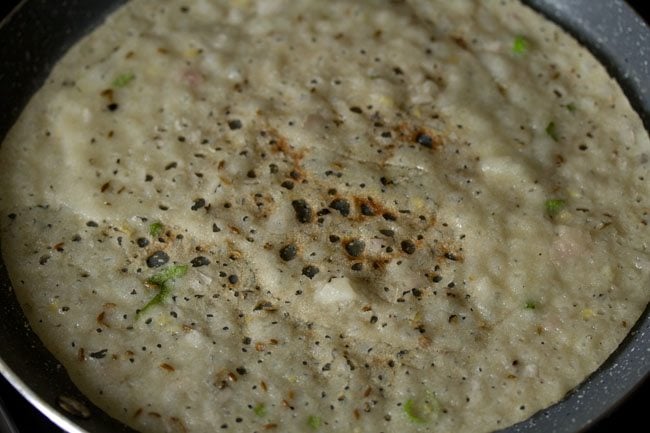
16. The longer you cook these, the more golden and crispy they become. Flip and cook the second side for ½ to 1 minute or as needed.
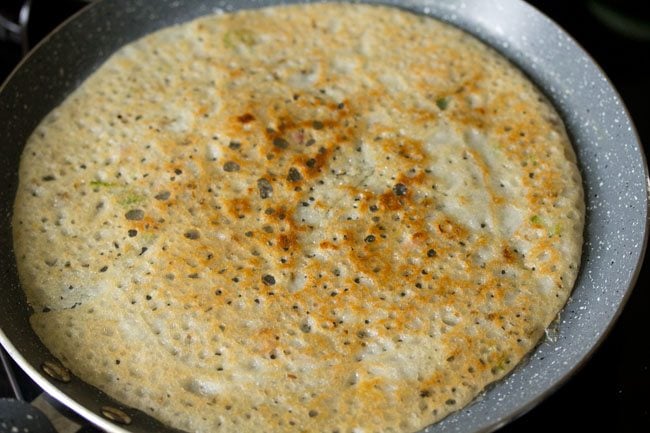
17. Fold and then serve instant rava dosa hot with Coconut Chutney and Sambar.
The flours settle down at the bottom of the batter. So you have to stir and mix the batter very well every time you make dosa.
In case the batter becomes thick after making a few dosa, then add some water and stir again. Make all dosa this way.
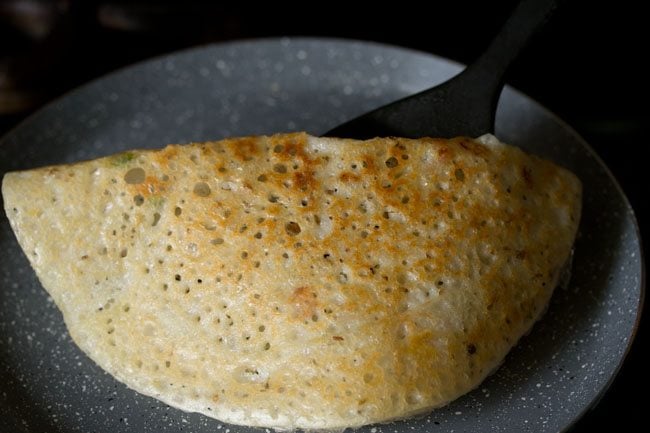
18. Serve rava dosa hot. For the best taste serve these as soon as they are made.
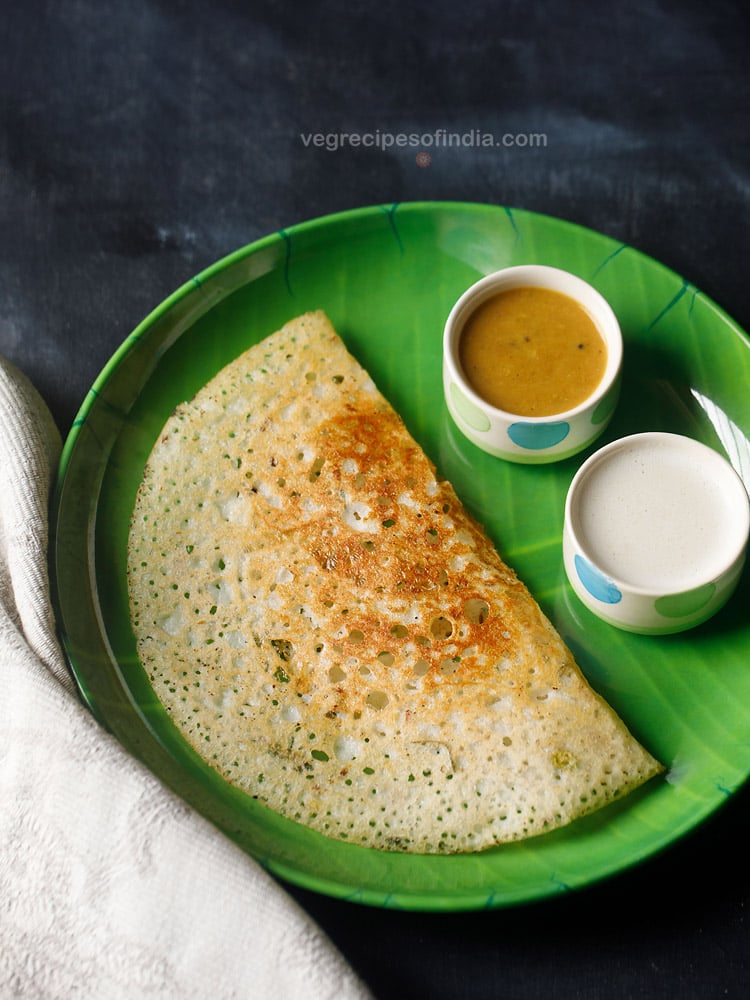
Serving Suggestions
Rava Dosa or Suji ka Dosa can be served with sambar, Coconut Chutney or Idli Dosa Podi or any chutney of your choice. To make it more filling, you can serve it with Potato Masala and make a delicious Masala Rava Dosa.
Rava dosa also pairs well with Peanut Chutney, Onion Chutney, Tomato Chutney and Ginger Chutney.
Variations
With the basic instant rava dosa recipe, many variations can be made.
- Increase or decrease any of the herbs and spices and make a variation. Example: you can make pepper rava dosa by increasing black pepper or onion rava dosa by increasing amount of onions.
- Add ghee or butter and make ghee rava dosa or butter rava dosa. Serve rava dosa with potato masala and you get masala rava dosa.
If you are wondering what is Rava
Rava stands for suji or semolina or cream of wheat. Hence this dosa is named after one of its main ingredients. The type of rava used is the fine variety of rava. You could also use Bombay rava to make these crispy crepes.
Rava is coarsely or finely ground husked wheat. Depending on the type of dish, the type of rava is used accordingly. E.g fine rava is used in making Rava Idli, Upma, sooji halwa, sheera etc.
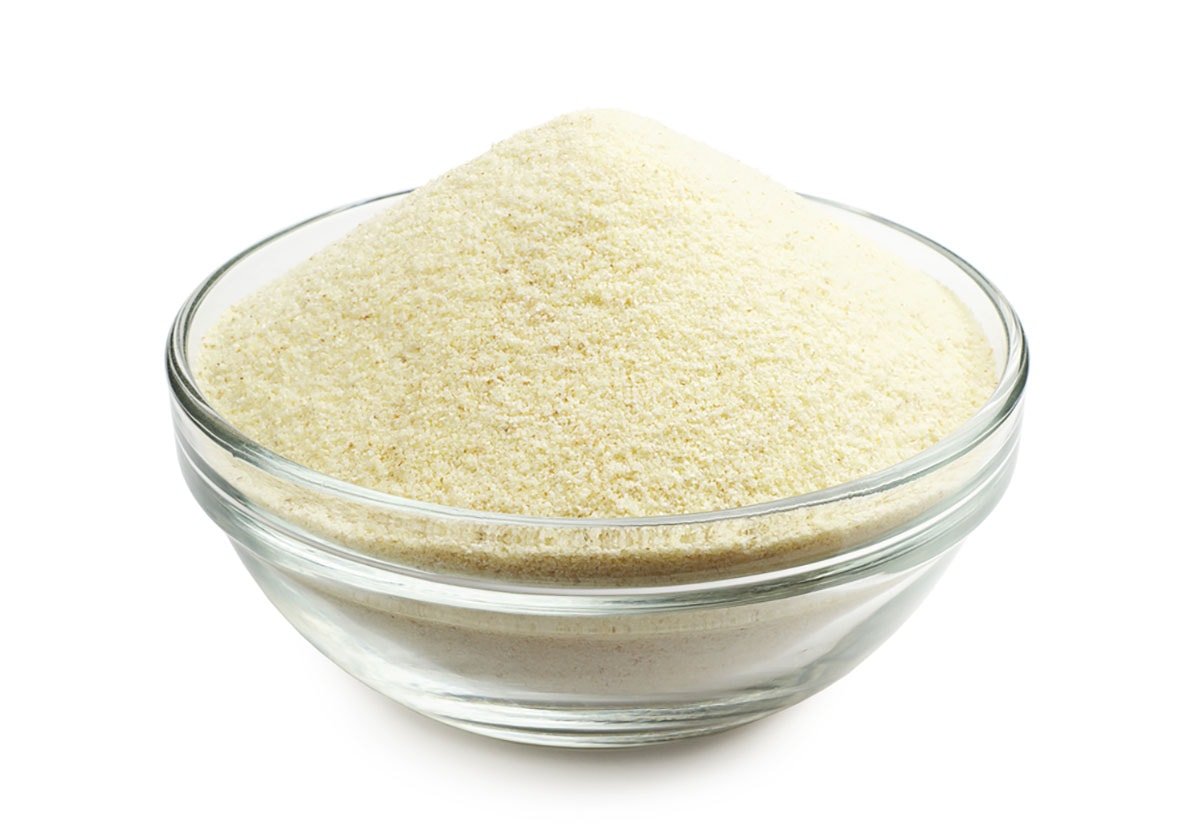
All the three terms suji, rava, semolina flour and cream of wheat mean the same. In western and southern parts of India, the word ‘rava’ is used.
In northern parts of India the word ‘sooji’ or ‘suji’ are used. Thus rava dosa can also be called as ‘suji ka dosa’ or ‘suji dosa’.
Expert Tips
- Soaking rava: Before making them, always allow a soaking time of 20 to 30 minutes for the batter.
- Batter consistency: The batter has to be thin and of pouring consistency. Even if the batter is of medium consistency, the Suji ka dosa will be soft and not crisp. When you make the first dosa then you will come to know whether you are getting the crisp and netted effect or not. If not then you will need to add some more water. Instead of water, you can also add buttermilk to the batter.
- Temperature of skillet or tawa: When pouring the batter, the skillet or tawa has to be hot. When you pour the batter, it will sizzle when it comes in contact with the hot tawa. So keep the heat to medium or medium-high. When cooking instant rava dosa, you can reduce the flame if the tawa becomes too hot.
- Pouring batter: The batter also has to be poured from a slightly more height than what is the norm. This will give you the netted effect on the Suji ka Dosa. When pouring the batter, pour from the edges first and then move towards the center.
- Cooking time: Rava dosa takes more time to cook than the regular dosa.
- Mixing batter: Every time before pouring the batter on tawa, you have to mix it very well as the flours and rava settle down at the bottom of the batter. After making some rava dosa, if the batter looks slightly thick, then you can add some more water.
- Pan type: Always use a heavy or a thick bottomed tawa or pan, so that the rava dosa does not stick to the pan. You can even use cast iron pan.
Your Questions Answered
Why rava dosa sticks to the pan or skillet?
When making rava dosa or any dosa for that matter, always use a seasoned pan. Iron tawa or iron skillets are the best for making dosa.
Seasoning means that the pan is ready to be used or has been used earlier to make dosa. Never use a pan or tawa in which you make roti or chapati as then the dosa will stick on the tawa.
Usually rava dosa does not stick on a non-stick pan if it is heavy or thick-bottomed. In case the dosa starts sticking on the non-stick pan, then make a few small dosa initially on it and later the dosa won’t stick.
How to season iron tawa (cast iron skillet)
- For an unseasoned or new iron tawa or iron skillet firstly heat the tawa. Spread some oil all over. Keep the flame to a medium or high and let the tawa get hot for 1 to 2 minutes.
- Lower the flame and wipe this oil with a cotton napkin or a paper towel. Spread another layer of oil and repeat the process. Lower the flame and then again wipe this layer of oil. Repeat this process once or twice.
- Now spread oil again. Make a small rava dosa. See if it sticks or not. If it sticks then repeat the seasoning method for 1 or 2 times more. Initially a few dosa, in the beginning, will stick, but later they won’t stick.
- After making all the dosa, when the iron tawa cools, then rinse tawa also and wipe it dry. You can then spread a layer of oil on it. Next time before making rava dosa, heat and then remove the oil and then start making dosa.
- You can even season the iron pan a few days before you plan to make rava dosa recipe. Repeat the above process of spreading oil and removing it, 3 to 4 times. Then lastly spread the oil. Switch off the flame.
- Keep the pan with the oil on it for a few days. Before making rava dosa, heat the pan. Then with a cotton napkin or paper towel wipe the oil. Spread oil again and heat it. Then wipe the oil again and then start making dosa.
More Dosa Recipes To Try!
Breakfast Recipes
Karnataka Recipes
Breakfast Recipes
Breakfast Recipes
Please be sure to rate the recipe in the recipe card or leave a comment below if you have made it. For more vegetarian inspirations, Sign Up for my emails or follow me on Instagram, Youtube, Facebook, Pinterest or Twitter.
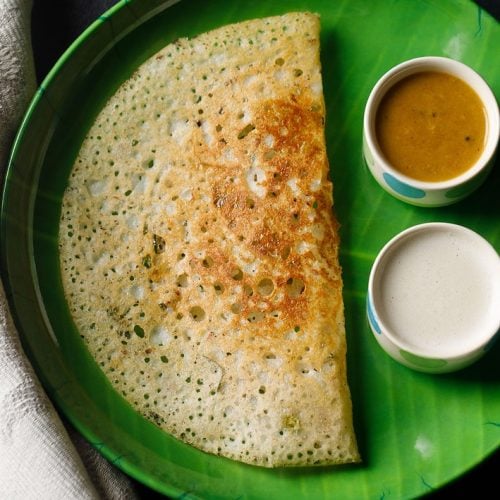
Rava Dosa Recipe (Quick & Crispy)
Ingredients
- ½ cup rava – un-roasted and fine textured (suji or fine semolina)
- ½ cup Rice Flour
- ¼ cup all-purpose flour
- ½ to 1 teaspoon green chillies – finely chopped or serrano peppers or 1 to 2 green chillies
- ⅓ cup onions – finely chopped
- ½ teaspoon ginger – finely chopped
- 1 tablespoon or 8 to 10 curry leaves – chopped
- 1 to 2 tablespoons coriander leaves – chopped (cilantro), optional
- ½ teaspoon black pepper – crushed
- ½ teaspoon cumin seeds
- 2.25 to 2.5 cups water or add as required
- salt as required
- oil or ghee or butter for cooking, as required
Instructions
Making batter
- Take unroasted fine rava, rice flour and maida in a bowl.
- Add the chopped onions, chopped green chilies ginger.
- Also add crushed black pepper, cumin seeds, chopped curry leaves and salt as required.
- Add water. Depending on the quality of rava and rice flour, you can add less or more water – from 2 to 2.5 cups water. I added 2.25 cups water.
- Whisk till smooth without any lumps. The batter has to be flowing and thin.
- If the batter looks thick or has a medium consistency, then add more water. If the batter looks very thin and runny, then add some rice flour.
- Cover and let the suji dosa batter rest for 20 to 30 minutes. Once the batter rests, you will see that the rava and the flours have settled down and the water will be floating on top.
Making rava dosa
- Before preparing dosa, mix the batter very well. Spread some oil on the tawa. Do make sure that the tawa is hot.
- With a ladle pour the dosa batter. Start from the edges move towards the center.
- If there are big or small gaps, then fill them lightly with the batter.
- On a medium-low to medium flame, cook the suji ka dosa.
- When the top side looks cooked, then sprinkle ½ to 1 teaspoon oil on the top and sides.
- Spread oil all over the dosa with a spoon.
- Rava dosa takes a little longer time to cook than regular dosa.
- Cook till the base is golden and crisp. The edges will also separate from the pan.
- The more you cook the rava dosa and the more golden it becomes, the more crisp it will be. Flip and cook the second side for ½ to 1 minute.
- Fold and then serve suji ka dosa hot with coconut chutney and sambar.
- The flours settles down at the bottom of the batter. So you have to stir and mix the batter very well every time you make dosa. In case the batter becomes thick after making a few dosa, then add some water and stir again.
- Serve rava dosa with coconut chutney or dosa podi or any chutney of your choice. They also taste good with peanut chutney or tomato chutney or ginger chutney or onion chutney.
- For best taste and texture I recommend to serve these as soon as they are made. This recipe can be easily scaled to make a small or a big batch.
- Store any leftover batter for a couple of hours in the refrigerator.
Video
Notes
- Resting batter: Rest the batter for 20 to 30 minutes.
- Batter consistency: The batter has to be thin and of pouring consistency. A medium consistency, will yield soft rava dosa.
- Temperature of the pan: When pouring the batter, the tawa has to be hot. When you pour the batter, it will sizzle when it comes in contact with the hot tawa. So keep the flame to medium or medium-high.
- Pouring batter: The batter has to be poured from a slightly more height and this gives a netted effect on the rava dosa. Pour from the edges first and then move towards the center. When you make the first dosa then you will come to know whether you are getting the crisp and netted effect or not. If not then you will need to add some more water. Instead of water, you can also add buttermilk to the batter.
- Cooking time: Rava dosa takes more time to cook than the regular dosa. You can reduce the heat if the tawa becomes too hot.
- Mixing: Every time before pouring the batter on tawa, you have to mix it very well as the flours and rava settle down at the bottom of the batter. After making some rava dosa, if the batter looks slightly thick, then you can add some more water.
- Pan type: Always use a heavy or a thick bottomed tawa or pan, so that the rava dosa does not stick to the pan. Cast iron pan is also a good choice.
Nutrition Info (Approximate Values)
Rava Dosa recipe from the archives was first published on May 2013.

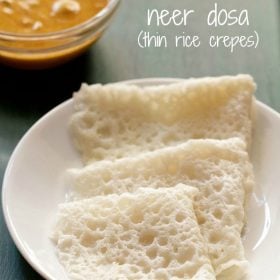
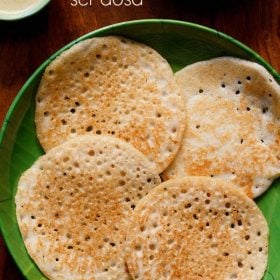
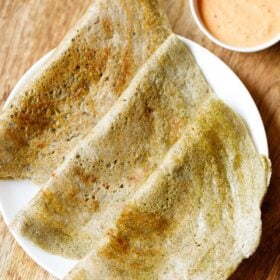











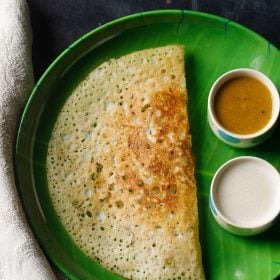
Super, really crispy.
Have been following this recipe for years, our entire family enjoys the delicious rava dosa.
Very good. Thank you. Now I don’t buy ready made packets for Rava dosa.
Most welcome. Nice to know and thanks for a wonderful feedback.
Best rava onion dosa recipe ever. I made these today morning. They came out so well and were just like restaurant style..
Great and thanks for sharing this super feedback.
Excellently and painstakingly drafted recipe, Dassana. Very clear instructions indeed.
Will try making Rava Dosa very soon. I don’t anticipate any difficulty with such clear-cut instructions and useful hints and tips to ensure success.
Thank you for all the trouble taken.
Thanks a lot Vanessa. I hope you are able to make perfect rava dosa with these clear instructions and the tips & hints. Most welcome and no trouble at all.
Thank you Dassana for sharing so many wonderful recipes. I have tried so many of your recipes and they always turn out so good and they are also easy to cook. This dosa recipe is absolutely delicious and easy to make!
Thank you Sandhya for this lovely feedback on the recipe and the rating too. Thanks also for letting me know about the other recipes you have made.
Very good information for beginners who have taken up cooking. Thanks
Very easy and nourished recipe. I was able to prepare it in the specified time perfectly. Thank you so much.
Glad to know and welcome!
It’s perfect, like all of your recipes. Tried it tonight and loved that it came out so well. Thanks so much for sharing.
Thanks for the positive review and the rating on the recipe. Most welcome and happy cooking.
Hi Dassana, I have made this Rava dosa many many times by now and each time the taste is consistent!! It’s now my hubby’s favorite Dosa. 🙂 I would like to ask if I can use the ingredients onions, chillies, ginger, pepper powder etc in regular Dosas like in Davangere Benne Dosa or plain Dosa?
Thank you for all your hard work.
Hi Lakshmi, thank you. Yes you can use the ingredients in the regular dosa. Just chop the onions, ginger and green chillies finely, so that you are easily able to spread. My mom used to make this version of spiced dosa with leftover dosa batter. It tastes good. Most welcome.
Hey, what could be the substitute for maida?
You can add whole wheat flour or gram flour (besan) instead.
Very good. As I didn’t have maida, tried without adding maida, still turned out good. Thanks Dassana.
thank you for this nice feedback. good to know that even without adding maida, the rava dosa turned good. happy cooking.
Dear dassana first for may God reward for all the hard work you have done to prepare this receipes with pictures in detail and posted it for us Who have never cooked in life. I cook. My own food now by going through your recepies .its so simple to understand and prepare it. I prepared rava dosa and most of my bharaini nationals loved it thank u and God bless
thank you very much. i am so happy that the detailed photos are helping you to cook. a comment like yours really makes me feel good as it fulfills the purpose of making the blog to help and teach people to cook in an online environment. thanks for your kind wishes too.
Dasanna,
I tried your Rava dosa, coconut and red chutney recipe yesterday. It was a super hit. Everyone at my home loved it. Thank you so much for posting amazing recipes.
thanks malvika for this awesome feedback. thanks for the rating too. glad to read. most welcome and happy cooking.
The rava dosai I made following your recipe has been the best by far. Thank you
thanks a lot veena. glad to read your feedback. thanks for the rating too on rava dosai recipe.
Hey there…..I am going to try this recipe tomorrow….very curious about it….but one doubt : can I make dosa a bit more thick ??? Please suggest…If yes then how should I make this….
you can make the batter thick. but a thick batter will give soft rava dosa. just add less water and make a slightly thick or medium consistency batter.
Thanks . This is the perfect recipe for rava dosa .
thank you shradha and welcome.
What else I May Use instead of Rice Flour, please Suggest me
you can use besan (gram flour) instead.
We enjoyed our breakfast , it was so perfect and yummy ???? thank you for sharing the recipe ????
welcome amrutha and thank you.
Hi dassana,
I have tried few recipes.They turned out to be great.Thank you for the detailed and pictorial explanations.
Can we use roasted semolina in this recipe?
Keep up the good work.God bless you.
thanks sowmia for your feedback and kind wishes. you can try using roasted semolina. if it is lightly roasted it is fine, but it should not be completely roasted. the texture of rava dosa is different when roasted rava is added.
Turned out yummy! Thanks Dassana. I’m a big admirer of your recipes plus your way of explaining simply just every single bit one need to know (pre or post or during the recipes). Hats off to the efforts you take. (My first comment ever on your blog :))
thanks harshada for the review as well as rating on rava dosa recipe. i am glad that you are finding the recipes explained well and easy to relate and understand. happy cooking. do comment whenever you have time or have a query.
Tried the rava dosa recipe. Turned out really well. Step by step explanation was very helpful. Buttermilk really adds a nice taste to the dosa. Thank you Dassana.
Welcome Nita. Glad to know that you liked this rava dosa recipe.
I will use a non-stick pan to cook the dosas. Do I need to oil the pan, or can I just bake them in the same way as ‘normal’ crispy dosas?
for rava dosa, you can spread some oil on the pan as the batter is poured and not spread. if you want you can also skip spreading the oil.
Tried this with packaged rice flour but the batter is sticking to the tawa even though I have a heavy bottom tabs and I brush it with oil. The batter sticks and burns. What else can I add to the batter? I tried your rava dosa with poha powder, that came out well. Please advise my batter is sitting in the fridge now.
season the tawa. heat it and spread some oil. keep the flame to a medium or high and let the tawa get hot for 1 minute. lower the flame and then wipe this oil. spread another layer or oil and repeat the process. lower and then again wipe this layer of oil. now spread oil again. make a small dosa. see if it sticks or not. if it sticks then repeat the seasoning method for 1 or 2 times more. initially a few dosas in the beginning will stick, but later they won’t stick. for the tawa also, after rinsing it, wipe it dry and spread a layer of oil. before making dosas, heat and then remove the oil and then start making dosas.
I am increasingly impressed by your recipes! Tried this instant rava dosa recipe today and I was over the moon! Loved the crispness and the taste. Pair d it with home grown Cuban oregano ( doddapatre) chutney… No more Udipi restaurant for Rava dosa at least! Kudos to you for your efforts!!
thank you alice. nice to read your feedback on the recipe. one can easily make hotel style food at home and it costs less than what we shell out in restaurants.
Hi Dasanna,
Tried the rava dosa. My kids just loved it. Only problem was that I cud not get that perfect round shape of dosa.
Thanks a lot.
U r doing a great job.
Thanks again.
Welcome Deepa. Good to know that everyone liked the rava dosa.
The dosa turned out very good!
thanks sweta for the feedback. glad to know.
Hi Dassana,
I tried making Rava Dosa . It turned really well. Thank you so much .i love your website .It’s so good. Kudos to you. .
Welcome Lakshmi. Thanks for your kind words.
Hi dassana,
I noticed that there is no souring agent in this while the usual dosa is sour. Will this taste good if we add curd or lemon to it?
zainab, souring agent is optional in rava dosa. i generally do not add. but you can add sour curd or lemon juice in the batter. it tastes good with sour curd as well as lemon. i have made rava uttapams with both sour curd and lemon and it tastes good.
can you please post potato sabzi served with rava dosa recipe?
sowmya, you can check this recipe (potato curry for masala dosa) – https://www.vegrecipesofindia.com/potato-curry-recipe-for-masala-dosa/
Please can you advise if we can use roasted suji as I have lot of roasted suji,would like to use it first before buying another lot.
prerna, you can add roasted sooji. texture of the dosa will be slightly different.
hi
all breakfast recipes are too good
i want to ask insteed of riceflour can i use gramflour
thanks jayamala. you can use besan instead of rice flour.
Hi again Dassana, tried this recipe and it was super yum and flavourful. I added ragi flour and wheat flour (instead of maida) too, methi powder and ginger powder instead of ginger in addition to the recipe you have posted. It was so tasty that my family had to be physically restrained until dinner time (I had made your mix veg sagu too) from finishing them right off the pan while I was making it. Thanks for another great home made recipe. Ever grateful! Ever motivated to opt for veg because of your site!
thanks a lot sonia for the feedback as well as for sharing your experience. ragi and whole wheat flour are healthy additions. i will try adding ragi next time. i have added wheat flour but never ragi. good to know that your family loved the rava dosa.
hey can we use the Rava used for upma?
the rava that is used for upma is what is used in making rava dosa.
Hi,
Thanks for sharing receipes in such illustrative manner. Makes cooking look so easy and fuss-free esp when we want to try variety.
I have a question for you.. Why do you add baking soda/ eno to your receipe of uttapam and not in the dosa? Can we use roasted Sooji as normally we store It like that only?
Thanks, Shivani
thanks shivani. you can use roasted sooji. but just make sure they are not too much roasted. a lightly roasted sooji is fine. uttapams are thick and soft. so to get the soft and fluffy texture i have added baking soda. if you do not add baking soda, the texture is not fluffy and light. in rava dosa, we do not need to add baking soda as rava dosa are thin and crisp.
Hi Dassana,
I Like your recipes and the way you explain with photograph and each every bit that should taken care at time of cooking.
Every time I made ravva dosa the outcome is very thick or sticky but tried in method u explained it is awesome.. Thank you
In fact my kid who always runs from food liked the Dosa and started asking “Mummy One more ” Thank you so much.
Please also add some rice recipes for lunch with support of your easy making
sowjanya, thanks a lot. glad to know that your kid liked the dosas 🙂
i have already added a lot of rice recipes and plan to add more. you can check here – https://www.vegrecipesofindia.com/recipes/rice-recipes/
I tried few of the recepies which turned out really good…but rava dosa had a taste of rawness in it…though i left the batter to rest for 40 to 50 min..
which rava did you use? the rava has to be the fine variety of rava. also if you cook well till the dosa is crisp and golden, then there will not be any raw taste of rava.
Hello Ma’am,
I tried to make Rava Dosa but unfortunately it sticks to the Tava and can’t be flipped / fold at all although I spread 1 teaspoon oil. Please advice. Thank you.
carol, the tava has to be well seasoned and a thick bottomed tawa. if the base is thin or if the tawa is not seasoned, then any dosa will stick. to season the tawa, oil has to be spread on a hot tawa. then switch off the flame and keep the tawa aside for a couple of days. before preparing the dosa, remove the layer of oil by wiping with a cloth or a kitchen paper tissue. heat the tawa again. spread some oil. again wipe. do this process once or twice. then spread the batter. the first few dosa may not come out well, but later you will get proper dosa. also use the tawa only for making dosas or shallow frying. do not use it for making rotis or chapatis. for rotis or chapatis, keep a separate tawa.
These are great tips, thank you.
welcome renuca.
yummy tempted and just now tried and finished it already.. it tasted awesome and thank you so much for sharing this easy peesy dosa. it was delicious ?
glad you liked the rava dosa preethi 🙂 thankyou for your kind words.
Rava dosa turned out amazing!! I keep trying your recipes everyday and i must admit, you have become a part of my everyday life 🙂
thankyou so much sindhu 🙂 pleased to know this and glad we could be a part of your life somewhere 🙂
All your recipes are truly good..
thankyou so much anita 🙂
Can you please post kids lunch box recipes that does not become bad for 7 hours
will try to add.
ma’am first of all heartiest thanks to u for this receipe. i just fond of eating rava dosa but in lucknow very few restro serve this dish and the price is also quite high.After i found this receipe on your site its easy for me to cook this at home and without costing me much.
till now i prepared paneer tikka,chole bhatura,paneer chilli dry and this is 4th in a row…and all are extremly delicious and wonderful
THANK U MA’AM.
thanks a lot nishant and happy cooking.
Hi,
Thank you again for this amazing recipe. I tried today and it came out delicious and beautiful.
Every time I wana try something new, I refer to your website and all recipes are too good.
Wonderful!
Keep up the good work.
glad you liked the recipes from blog hiral thankyou for trying them 🙂 and you are welcome.
I’ve enjoyed all your recipes. Keep up the great work.
I tend to like my dosas slightly sour/fermented, so I added a tablespoon of dahi (yoghurt) to your recipe, and let the batter sit at room temperature for 48 hours. Here, i the USA, it’s pretty cool, so the fermentation time is longer than in India – where overnight fermentation would possibly be adequate. Came out very good.
One book that you might enjoy (get the 2004 edition second-hand from Amazon) is Harold McGee’s “On Food and Cooking”. McGee is 1/4 Bengali – his father was Californian, his mother Anglo-Indian. His book deals with the science behind cooking, though it doesn’t have a single recipe in it. In the book, there’s a section on Fermented Legumes of India, where he discusses dhokla, idli/dosa and so on – the fermentation is due to a mixture of lactobacillus (same as dahi) and natural yeasts (which make naan rise).
thanks prakash. good of you to share the tip on dahi. 48 hours is a long time and now i can imagine how cold or cool USA is. here in india, in cold weather, i keep for 14 to 15 hours to get the batter to ferment. thanks also for sharing this book. i have noted it down and will buy it. the book looks interesting.
hi dasna.its very good recipe.and very easy.my kids also love idli dosa very much.
thankyou mohsina 🙂
It’s very easy & tasty
thankyou shubhada 🙂
very tasty and awesome recipe
thanks rita
I lv ur recipe…. Its very easy n tasty.
My kids.like rava idli. So today I going to make
I love ur recipe and making method
thanks pooja
Going to try tomorrow!
I did this today, and it was divine! The kids loved it.
Thank you.
welcome ashok
Its taste is very awesome!
thanks karthik
Hi. Can I substitute the rice flour with something else? Thanks.
welcome pia. rice flour is required.
Dassana, I never tried this but I am wondering substituting white corn flour for rice flour might work. Of course , the taste might be different but it might be worth a try.
rom, you can try. but the taste and texture will be different. little experimentation in recipe will be required.
Hi I tried this recipe today and the taste was perfect however my dosas were not as crispy as I would have liked, how can I make them more crispy?
anu, make the batter thin. if the batter is thin then the dosa will come out crisp. if the batter is thick then the dosa comes out thick and soft.
Thanks, I made it again today and made the batter thinner and it came out perfect! Thankyou!
welcome anu. good to know this.
It’s a really yummy :>
thanks diu
Your recipes are fantastic! One easy way I have discovered is to use an electric hot plate (the long rectangular ones) at 350F. Not only will you not need to flip the dosas, but they will cook evenly. Plus you get a hotel style long dosa, perfect when you are feeding multiple people at once!
thanks shivani for the suggestion and the tips.
I was thinking the same, about using an electric griddle (hot plate as you put it), but how do you spread it? Tava has a natural gravitational effect because of its slight curvature. If I spread it like a regular dosa using a flat ladle (to spread it), I will not get the bubbly effect of a rava dosa.
Hi Dassana,
As I always say, Urs is da blog i turn towards whenever i need to cook sumthing new. This rava dosa recipe was sumthing i ws looking for since long and the video gave a lot of confidence to try it. But alas, my dosas did not come out well 🙁 . Please give an idea how much time approx it takes to cook before flipping it to other side. Mine took not less than 6 min. Isn’t dat too long? I couldn’t flip them before dat and after 5-6 min, the dosa was badly sticking to the tava. I used non stick tava. Please help.
thanks himani. the batter become too watery. thats why so long to cook. the texture of the batter which has too much of water is very smooth and loose and the dosa breaks when flipping. it cannot be flipped in one whole round. next time add less water and just sprinkle a few spoons. if the dosa looks thick, then just add a few tbsp of water. anytime when you make this dosa, you will know when cooking if the batter is thin or thick. for a thin batter, you add more of the rava or rice flour and it thickens. also when you make dosa, each time, you have to stir the whole batter in the bowl very well. what happens is the rava settles down at the bottom and a thin watery batter is at the top. so if you don’t stir, you take the top watery batter and the dosa does not come out well. so stir the whole mixture very well and then take a ladle and pour the batter. this has to be done every time you make the dosa.
Hi Namaste.
May Goddess Annapurneshwari blessings be with you for making very delicious and healthy cakes receipes especially eggless ones. This web site taught me so many receipes. Rava dosa is one. One receipe for all my family . Bunch of thanks to you .
welcome manjula. thanks for sharing your blessings and positive feedback. i have a statue of ma annapurna in my kitchen. before starting cooking i always remember ma annapurna. some time i don’t even taste the recipes because i offer them first to ma and lord ganesha.
સરસ રેસીપી છે…..
thanku 4 recipe
welcome yugandhar
Thanks a lot for this recipe. I loved it.
welcome helena
The best way to learn cooking thank u so much 🙂
welcome gudie
Very yummy recipe
thanks shweta
I enjoy cooking n m very interested in d dishes that u publish
kuljit, nice to know that.
Good recipes
Good recipes
I like all.recipe teach by u.how to make coconut chutney.pls tell me. thanks
you can check the recipes for coconut chutney on the blog. they have been tried and tested by readers too.
SUPER
To ensure the dosas do not stick to the tawa, heat the tawa, rub a raw onion/potato over it ,sprinkle some drops of water and then spread the batter.
The recipes are so easy and educative too……..in the same league as Shantadevi Malwad’s.
Thank you .
thanks anusha. thanks for the tip. i know this, but i have no where mentioned in detail on this dosa post. thanks. will help the readers. but this can only be done with an iron tava and not non stick ones. i did not know who is shantadevi malwad. so i searched on google. thanks for that.
kitna temp i have to keep. please explain that too. i am novice at south indian stuff. thanks
i followed the recipe as it and applied oil as you are suggesting but dosa ki outer edges didnot curl up and i could not flip it. i tried 5-6 times. it was a mess washing and trying but anyways it didnot work out. i used rajdhani sooji and i used regular iron tawa we have at punjabi homes for roti. any suggestions ya??
hi jhanvi. when making this dosa or any dosa, its always better to use a non stick pan. if you don’t have a non stick pan, than iron tawa also works well, but then the iron tava should be used only for making dosa. you can even do shallow frying of tikkis on this tava. but don’t ever make rotis.
if the roti wala tava is used, then the dosas will stick and becomes a mess. i have two tava at home. one for making rotis and the other for making dosa. when using first time, the tava should be seasoned first with oil. meaning oil should be applied on the tava and kept for a few days. then wipe the oil and begun making the dosa. the first 2-3 dosa will stick. but later one you will get proper dosas.
the fire can be low to medium. it the pan is too hot, then the dosa gets browned quickly and there is uneven cooking. rava dosa takes a longer time to cook than plain dosa.
Hi Dassana, loved this recipe …it’s perfect for us, my 6yr old son loves his dosa crisp….I never got it with my other recipe …u r doing a great job …keep up the good work!God bless!
thanks rashmi. i am glad you all liked the dosa.
Hey Dassana,
Can we use bangalore/bansi rava for this recipe?
thnks and keep up the good work!
the rava has to be fine like the bombay rava. i checked pics of bansi rava and they looked a bit coarse to me. so i suggest using fine rava to make rava dosa.
The dosas look perfect, with the crisp edges. I too make it like this, I just use wheat flour instead of maida.
yes poornima you are right, whole wheat flour can also be substituted.
Tried this and we all loved it at home. The video helped of course. Thanks Dassana.
thanks poornima.
Hi Dassana,
Wow..a dream come true actually. Always wondered how you cook n wished you’d add a video. I just saw your recipe mail n usually I browse to see what recipes you have posted n check it later. I saw video on the rava dosa one. Yipee I got to see it! Was hoping to see you, however this was a great surprise too.
Congratulations on your first video n thank you for taking this big step. Will give this a shot tommorrow for breakfast. It gives me more confidence n the dosa looks so tempting. God bless
thanks teju. the video was an amateur one. its pretty difficult when you are cooking as well as shooting. i plan to add more videos. they are faster and easier to edit then pics. do let me know how was the rava dosa.
Dasana, I tried it this morning today, simply awesome. Just like I enjoy at south indian hotels. I was looking for this kinda recipe and glad I found it. Thanks for posting again!
thanks megha for writing back and sharing your positive feedback.
I have a problem with rava dosa. I use non stick . but dosa sticks to the pan and does not come out. what could be mistake.
venkat, you can apply oil before pouring dosa batter on pan.
ideally it should not stick or there is something wrong with the dosa batter or pan.
adding oil should solve the issue.
Hi Dassana
i will try this recipe this weekend..
can we skip maida in it….
and one more question…is there any alternative for imli and tomato in recipes as my mother cannot take it due to ayurvedic treatment….we don’t get kokum here in north india otherwise i have heard it is one…..
hi renuka, instead of maida, you can add whole wheat flour.
for sourness in food lemon juice or even raw mangoes or amchur powder can be added. i am not sure if your mother cannot take these too. sour buttermilk or curd can also be added. another souring agent is dry pomegranate powder. so depending on the recipe, these souring agents can be used. also natural vinegars like coconut vinegar or apple cider vinegar are also good. but vinegar cannot be added to any recipe like dals or sambar. kokum is very good. i wonder why its not available in north india.
I tried it today and the dosas are really yummy and crispy thanks for sharing the recipe. Your video was really helpful. Keep up the good work.
thanks rujuta for trying the recipe and giving the feedback.
The dosa looks so crisp and nice, its my fav :). The video is WOW dassana, great start and now waiting for many many more of such video’s! All the best.
thanks anamika
i have a version in drafts too but the ingredients are slightly different. don’t think we add maida. love the lacy and crisp dosas in the first pic.
nags, i will look forward to your version of rava dosa. i am sure it will be tasty.
I had been wishing you did a video series of your recipes. This video was awesome, very clear.
I wish you lots of luck!
thanks familycook.